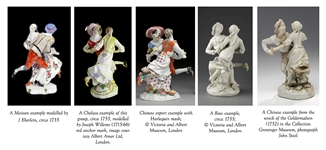What are you looking for?
searchChinese export porcelain figure group of two dancers
Chinese export porcelain figure group of two dancers
SOLD
Qianlong c 1750-1752
Dutch Market
Height: 6¼ inches; 15.5cm
A fine and rare figural group of two dancers modelled after a Meissen original and brightly enamelled in famille rose, the man with yellow hat, blue waistcoat and red breeches, the woman with red waistcoat and skirt with purple flowers, the base with modelled flowers scattered between their feet.
This model was first made by Johann Friedrich Eberlein in 1735 for Meissen and was reworked by Johann Joachim Kändler and listed in his Taxa of 1743 as "Harlequin and a maiden doing a Polish dance, possibly the Mazurka." It was a very popular group and was copied by Bow, Chelsea and possibly Derby. This is the finest of export figures modelled after European groups and very few examples are known, each having slightly different decoration to the clothing of the figures. However when the wreck of the VOC ship Geldermalsen was salvaged in 1985 a number of damaged examples were recovered though they had lost their enamels due to the corrosion of the seawater. The ship sank in 1752 so a date for these pieces can be proposed with reasonable accuracy.
This group also probably served as inspiration for another rare figure group of a Dutch couple dancing. The legs are splayed in the same way though the modelling is much clumsier and with less movement (see left).
References: Howard (1994), p253, cat 300, illustrations of a headless pair from the Geldermalsen wreck and an original Meissen group; Jörg (1986) p104, fig 102 an example from the wreck; Scheurleer (1974), cat 331, an example of this group in the Groninger Museum, where they now also have an example from the Geldermalsen, with heads intact; Wirgin (1998), p203, cat 221 another example with very similar colouring; Du Boulay (1963), fig 128, another example; Sargent (1991), p222-3, an example of the Dutch couple dancing; Cohen & Motley (2008), p292, another example of this group; similar examples are also in the Fitzwilliam Museum, Cambridge; the Victoria and Albert Museum, London has a unique example (illustrated in Clunas 1987, fig 53 and Kerr & Mengoni 2011, p77) which is smaller than this one and the man has a Harlequin’s mask over his face and a different hat, copied from a different version (probably the Chelsea one of 1756 which has this masked man) - this example also has a very unusual impressed flower mark in the base and is currently exhibited next to a headless example from the Geldermalsen wreck.





